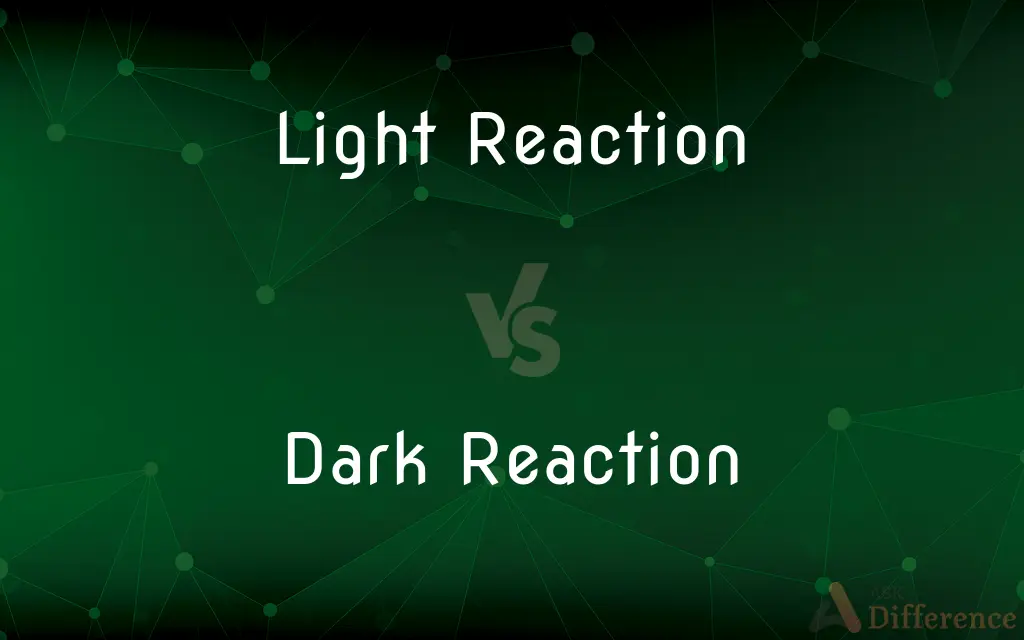Light Reaction vs. Dark Reaction — What's the Difference?
By Tayyaba Rehman — Published on December 26, 2023
Light Reaction uses sunlight to produce ATP and NADPH; occurs in thylakoids. Dark Reaction uses ATP and NADPH to produce glucose; occurs in the stroma.

Difference Between Light Reaction and Dark Reaction
Table of Contents
ADVERTISEMENT
Key Differences
The Light Reaction and Dark Reaction are two sequential processes in photosynthesis. In the Light Reaction, chlorophyll and other molecules absorb light energy, primarily from the sun. This energy splits water molecules, releasing oxygen and forming ATP and NADPH, two energy-carrying molecules. Without the Light Reaction, the Dark Reaction wouldn't receive the necessary energy and electrons to function.
On the other hand, the Dark Reaction, also known as the Calvin Cycle, does not directly depend on light. Even though it's called the Dark Reaction, it doesn't necessarily occur only in the dark. This phase uses the ATP and NADPH produced by the Light Reaction to convert carbon dioxide and other compounds into glucose. While the Light Reaction is all about energy capture, the Dark Reaction is about building molecules.
The Light Reaction takes place in the thylakoids of chloroplasts, while the Dark Reaction occurs in the stroma of chloroplasts. Essentially, the Light Reaction sets the stage, producing the required energy, and the Dark Reaction uses this energy for production.
To summarize, the Light Reaction captures energy from sunlight and produces ATP and NADPH. In contrast, the Dark Reaction uses these products to create glucose, an energy-rich molecule, from carbon dioxide.
Comparison Chart
Dependency on Light
Directly depends on light
Doesn't directly need light
ADVERTISEMENT
Location
Thylakoids of chloroplasts
Stroma of chloroplasts
Products
ATP, NADPH, O2
Glucose
Main Role
Energy capture from sunlight
Building molecules (glucose production)
Main Reactants
Water, light
ATP, NADPH, Carbon dioxide
Compare with Definitions
Light Reaction
A phase in photosynthesis where light energy is converted to chemical energy.
The Light Reaction provides the energy needed for the Calvin Cycle.
Dark Reaction
Takes place in the stroma of chloroplasts.
Enzymes essential for the Dark Reaction are located in the stroma.
Light Reaction
Leads to the splitting of water and release of oxygen.
During the Light Reaction, oxygen is released into the atmosphere.
Dark Reaction
Converts carbon dioxide into glucose using ATP and NADPH.
The primary goal of the Dark Reaction is to produce energy-rich glucose molecules.
Light Reaction
Directly depends on light to function.
Without sunlight, the Light Reaction cannot proceed.
Dark Reaction
Also referred to as the Calvin Cycle.
The Dark Reaction is where carbon fixation occurs.
Light Reaction
The process in photosynthesis that involves the production of ATP and NADPH.
Without the Light Reaction, the plant wouldn't have the energy carriers for further reactions.
Dark Reaction
A phase in photosynthesis responsible for glucose production.
The Dark Reaction utilizes ATP and NADPH to form glucose.
Light Reaction
Occurs in the thylakoids of chloroplasts.
The Light Reaction's location allows for efficient light absorption.
Dark Reaction
Does not directly depend on light to function.
The Dark Reaction can proceed as long as it has ATP and NADPH, even without direct light.
Common Curiosities
What initiates the Light Reaction?
The absorption of sunlight by chlorophyll initiates the Light Reaction.
Can the Dark Reaction occur at night?
Yes, the Dark Reaction can occur anytime as long as it has ATP and NADPH.
Is the Dark Reaction the same as the Calvin Cycle?
Yes, the Dark Reaction is also known as the Calvin Cycle.
What are the products of the Light Reaction?
The main products are ATP, NADPH, and oxygen.
Can the Dark Reaction happen without the Light Reaction?
No, the Dark Reaction needs ATP and NADPH, which are produced by the Light Reaction.
Why is the Dark Reaction named so?
It's named the Dark Reaction because it doesn't directly need light to function.
Is carbon dioxide used in the Light Reaction?
No, carbon dioxide is used in the Dark Reaction to produce glucose.
Where does the Light Reaction take place?
The Light Reaction occurs in the thylakoids of chloroplasts.
Where do plants get the energy for the Dark Reaction?
The energy for the Dark Reaction comes from ATP and NADPH produced in the Light Reaction.
How is water utilized in the Light Reaction?
Water is split during the Light Reaction to produce oxygen and electrons.
What is the main role of the Dark Reaction?
Its main role is to produce glucose using ATP and NADPH.
Do plants release oxygen during the Dark Reaction?
No, oxygen is released during the Light Reaction when water is split.
Does the Light Reaction directly produce glucose?
No, glucose production is the role of the Dark Reaction.
What would happen if there's no sunlight?
The Light Reaction would cease, leading to a halt in ATP and NADPH production.
Can the Light Reaction and Dark Reaction occur simultaneously?
Yes, they can occur simultaneously during the day when there's sunlight.
Share Your Discovery

Previous Comparison
Assumed vs. Disguised
Next Comparison
Legislative Assembly vs. Legislative CouncilAuthor Spotlight
Written by
Tayyaba RehmanTayyaba Rehman is a distinguished writer, currently serving as a primary contributor to askdifference.com. As a researcher in semantics and etymology, Tayyaba's passion for the complexity of languages and their distinctions has found a perfect home on the platform. Tayyaba delves into the intricacies of language, distinguishing between commonly confused words and phrases, thereby providing clarity for readers worldwide.
















































